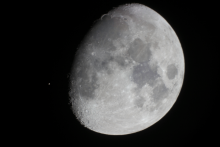Listen to today's episode of StarDate on the web the same day it airs in high-quality streaming audio without any extra ads or announcements. Choose a $8 one-month pass, or listen every day for a year for just $30.
You are here
Venus and Aldebaran
Two of the most striking objects in the night sky are meeting in the east before dawn over the next couple of weeks: the planet Venus and the star Aldebaran. Venus is the brilliant “morning star,” so you can’t miss it. And Aldebaran shines bright orange — the baleful eye of the celestial bull.
Tomorrow, Venus will stand almost directly above Aldebaran. Over the next few days, though, Aldebaran will pass Venus as it climbs higher into the sky. And after that, it’ll pull away from the brilliant planet, quickly leaving it behind.
Their motions are different because of their different positions relative to Earth.
Aldebaran and the other true stars are so far away that they appear to move across the sky as a group — the relative positions of any two stars always stays the same. But Venus is a planet, so it’s much closer to us. In fact, it’s the closest planet of all.
Venus orbits the Sun inside Earth’s orbit. So Venus and Earth are like two runners on a circular track, with Venus on the inside lane and Earth farther out. Because Venus has a shorter distance to cover, it takes less time to complete each lap. So its position against the background of more-distant objects — the stars — changes from day to day. The change is especially noticeable when Venus is passing by an especially bright star such as Aldebaran.
So watch Venus and Aldebaran as they cruise past each other in the early morning sky over the next couple of weeks.
Script by Damond Benningfield




